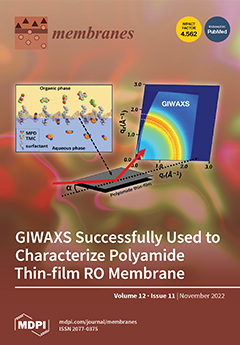A novel rapid and sensitive optical sensor for Cu
2+ ion detection based on 5,5,7,12,12,14-hexamethyl-1,4,8,11-tetraazacyclotetradeca-7,14-dienium dibromide (TL) immobilized on Santa Barbara Amorphous (SBA-15) has been successfully developed. The inner and outer space of SBA15 allowed a high capacity of TL compound to immobilize
[...] Read more.
A novel rapid and sensitive optical sensor for Cu
2+ ion detection based on 5,5,7,12,12,14-hexamethyl-1,4,8,11-tetraazacyclotetradeca-7,14-dienium dibromide (TL) immobilized on Santa Barbara Amorphous (SBA-15) has been successfully developed. The inner and outer space of SBA15 allowed a high capacity of TL compound to immobilize onto it. FESEM (Field Emission Scanning Electron Microscopy) analysis was performed to confirm the morphology of TL-SBA15, while FTIR (Fourier Transform Infrared Spectroscopy) was utilized to confirm the interaction of TL–SBA15. A binding study of TL compound towards Cu
2+ ion was performed via UV-vis solution study and binding titration. The stoichiometric binding ratio and binding constant value K
b of TL towards Cu
2+ ion was 1:1 and 2.33 × 10
3 M
−1, respectively. The optical reflectance sensor based on the TL compound is selective to Cu
2+ ion and demonstrated a linear response over a Cu
2+ ion concentration range of 1 × 10
−7 M to 2 × 10
−5 M, with a detection limit (LOD) of 1.02 × 10
−7 M (R
2 = 0.99) and fast response time of < 1 min. It showed high reproducibility, with a relative standard deviation (RSD) obtained at 0.47%. This optical sensor is reusable up to five consecutive times on Cu
2+ ion by using 0.1 M EDTA with a pH of 6 as a regeneration solution, with a reversibility RSD value of 0.79%. The developed optical sensor provides a rapid and sensitive tool for Cu
2+ ion detection in teabag samples, and the results align with those obtained by the ICP-MS standard method.
Full article






